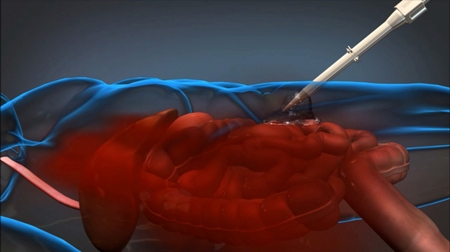Dec 13 2012
The Department of Defense’s medical system aspires to a standard known as the “Golden Hour” that dictates that troops wounded on the battlefield are moved to advanced-level treatment facilities within the first 60 minutes of being wounded.
 The foam-based product developed by Arsenal Medical for DARPA can be injected into a wounded servicemember on the battlefield to slow blood loss until the patient can be transported to an appropriate medical facility.
The foam-based product developed by Arsenal Medical for DARPA can be injected into a wounded servicemember on the battlefield to slow blood loss until the patient can be transported to an appropriate medical facility.
In advance of transport, initial battlefield medical care administered by first responders is often critical to injured servicemembers’ survival. In the case of internal abdominal injuries and resulting internal hemorrhaging, however, there is currently little that can be done to stanch bleeding before the patients reach necessary treatment facilities; internal wounds cannot be compressed the same way external wounds can, and tourniquets or hemostatic dressings are unsuitable because of the need to visualize the injury. The resulting blood loss often leads to death from what would otherwise be potentially survivable wounds.
DARPA launched its Wound Stasis System program in 2010 in the hopes of finding a technological solution that could mitigate damage from internal hemorrhaging. The program sought to identify a biological mechanism that could discriminate between wounded and healthy tissue, and bind to the wounded tissue. As the program evolved, an even better solution emerged: Wound Stasis performer Arsenal Medical, Inc. developed a foam-based product that can control hemorrhaging in a patient’s intact abdominal cavity for at least one hour, based on swine injury model data. The foam is designed to be administered on the battlefield by a combat medic, and is easily removable by doctors during surgical intervention at an appropriate facility, as demonstrated in testing.
DARPA's Wound Stasis Technology Could Save Lives
Wound Stasis performers presented pre-clinical data on the foam treatment at the 2012 Annual Meeting of the American Association for the Surgery of Trauma in Kauai, Hawaii. These data demonstrated the ability of the foam to treat severe hemorrhage for up to three hours in a model of lethal liver injury. During testing, minimally invasive application of the product reduced blood loss six-fold and increased the rate of survival at three hours post-injury to 72 percent from the eight percent observed in controls.
“Potentially, Wound Stasis provides an important addition to our ability to save life and limb. Getting after these heretofore difficult-to-stabilize, if not untreatable wounds, expands our options and effectively extends the ‘Golden Hour,’” said Maj. Gen. Bill Hix, Director of Concept Development for the Army Capability Integration Center at Training and Doctrine Command. “A capability like this is important in any operation, but would prove vital during operations in austere areas where military resources and infrastructure are at a premium,” he said.
“Wound Stasis has been an exciting program because we were able to move unexpectedly from fundamental research to a pre-clinical proof-of-concept based on the strength of our findings,” said Brian Holloway, DARPA program manager. “According to the U.S. Army Institute of Surgical Research, internal hemorrhage is the leading cause of potentially survivable deaths on the battlefield, so the Wound Stasis effort should ultimately translate into an increased rate of survival among warfighters. If testing bears out, the foam technology could affect up to 50 percent of potentially survivable battlefield wounds. We look forward to working with the U.S. Food and Drug Administration on future regulatory submission of this device, and with our partners, the Army Institute of Surgical Research and Special Operations Command, on getting this technology to where it’s desperately needed on the front lines.”
The foam is actually a polyurethane polymer that forms inside a patient’s body upon injection of two liquid phases, a polyol phase and an isocyanate phase, into the abdominal cavity. As the liquids mix, two reactions are triggered. First, the mixed liquid expands to approximately 30 times its original volume while conforming to the surfaces of injured tissue. Second, the liquid transforms into solid foam capable of providing resistance to intra-abdominal blood loss. The foam can expand through pooled and clotted blood and despite the significant hydrostatic force of an active hemorrhage.
In tests, removal of the foam took less than one minute following incision by a surgeon. The foam was removed by hand in a single block, with only minimal amounts remaining in the abdominal cavity, and with no significant adherence of tissue to the foam. Features appearing in relief on the extracted foam showed conformal contact with abdominal tissues and partial encapsulation of the small and large bowels, spleen, and liver. Blood absorption was limited to near the surface of the foam; the inside of the foam block remained almost uniformly free of blood.
DARPA recently awarded a $15.5 million Phase II contract to Arsenal Medical to continue development of the treatment system and support regulatory submission. DARPA anticipates continuing the Wound Stasis program through at least FDA approval of a prototype device.